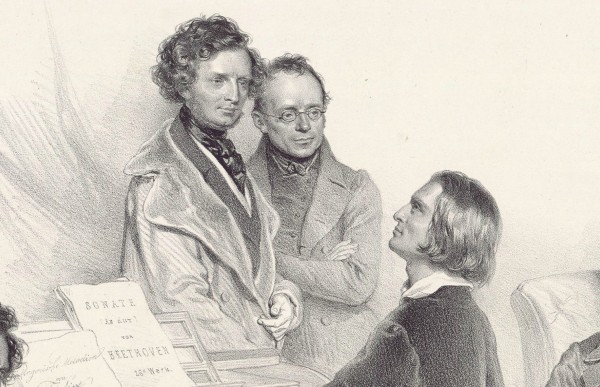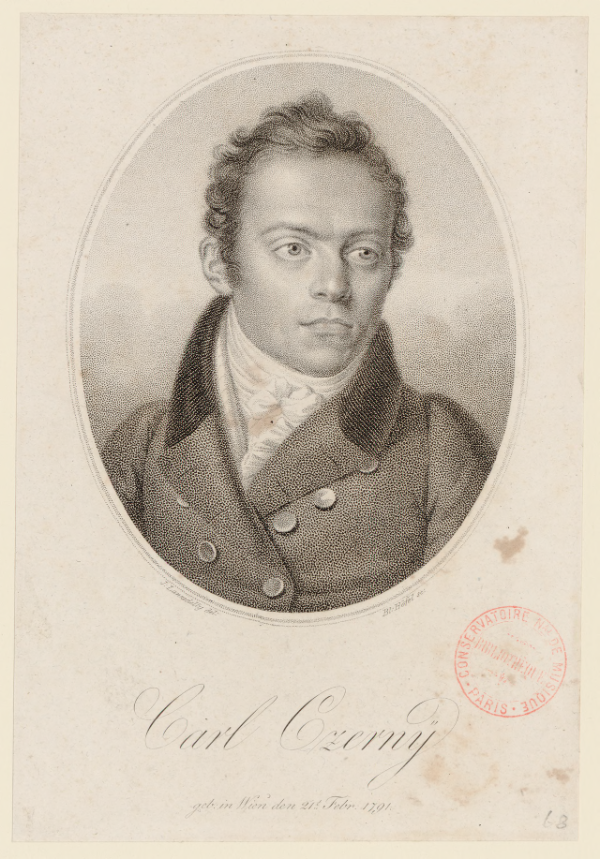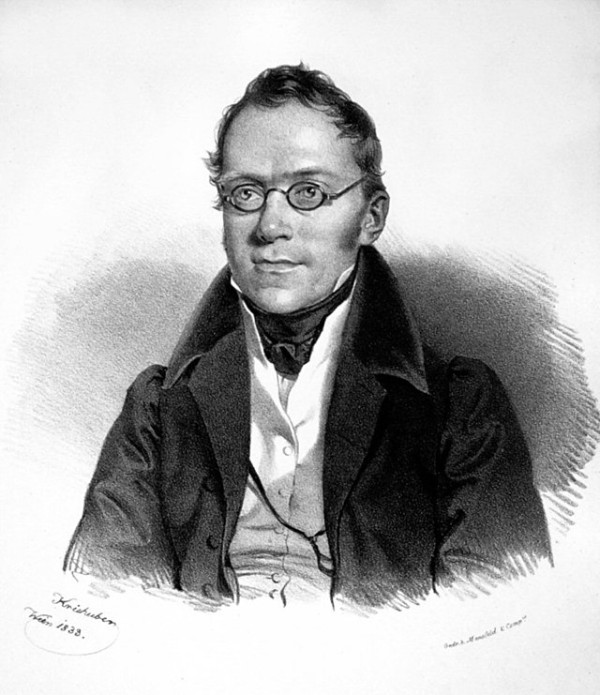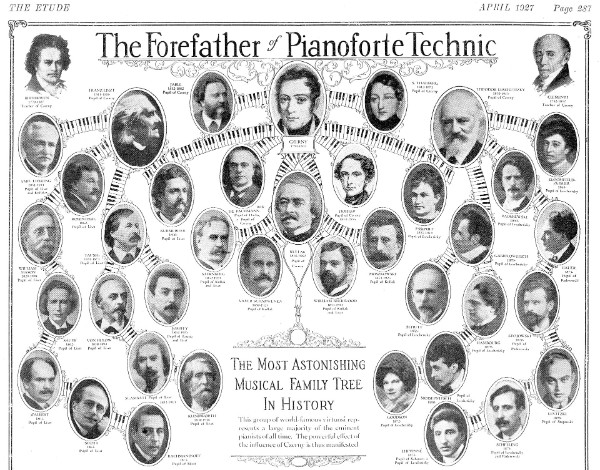The Austrian composer, pianist and teacher Carl Czerny (1791–1857) is best known for his extensive pedagogical works, such as his études and exercises. Yet, Czerny was more than just a teacher of technique. He was a visionary who understood the evolving demands of the piano and the pianist, helping to shape the very vocabulary of modern piano playing.

Hector Berlioz, Carl Czerny and Franz Liszt
Carl Czerny: 8 Nocturnes, Op. 368, No. 1 in E Major (Roberte Mamou, piano)
Between Two Giants
Czerny was a musical bridge between the Classical and Romantic eras, most notably as a student of Ludwig van Beethoven and later as the teacher of Franz Liszt. Beethoven considered Czerny the favoured interpreter of his keyboard works, and Czerny equipped Liszt with the polish and finesse to embark on his pianistic conquer of the world.
Czerny decided against international concert tours but rather composed and taught with astounding energy that left the world a legacy of around 1,000 compositions and treatises on almost all aspects of pianism at the time. However, to reduce Czerny’s importance to his didactic works alone is to overlook some delightful gems in his compositional output.
Carl Czerny: 8 Nocturnes, Op. 368, No. 2 in E-flat Major (Roberte Mamou, piano)
Echoes in the Drawing Room
Czerny’s expansive compositional output includes symphonies, concertos, chamber music, and liturgical works, many of which are only now being rediscovered and appreciated for their craftsmanship and musical insight.
Czerny also composed a significant body of concert music, among them a number of Nocturnes. These nocturnes reflect the Biedermeier aesthetic, a style prevalent in early 19th-century Central Europe that emphasised domesticity, intimacy, and refined sentimentality, appealing to the growing middle-class audience for home music-making.
To commemorate Carl Czerny’s passing on 15 July 1857, let us sample two sets of his nocturnes, pieces that, with their exquisitely sensitive tonal colourings, small-scale construction and constrained emotions, beautifully fit the Viennese households at the time.
Carl Czerny: 8 Nocturnes, Op. 368, No. 3 in A-flat Major (Roberte Mamou, piano)
Embracing a New Romantic Genre
Carl Czerny was acutely aware of the music of John Field and likely encountered nocturnes through published music and performances. Since he was an avid writer of salon-style music and was receptive to new stylistic developments, it’s hardly surprising that he would also engage with this genre.
Each of the Czerny nocturnes is a self-contained character piece, designed to evoke a particular emotional or psychological state. Written for solo piano, the Czerny nocturnes are relatively short, fitting the Biedermeier ideal of accessible, expressive music for domestic settings.
Carl Czerny: 8 Nocturnes, Op. 368, No. 4 in D-flat Major (Roberte Mamou, piano)
Melodic Lyricism

The young Carl Czerny
The hallmark of Czerny’s nocturnes lies in their melodic lyricism, a quality that aligns them with the nocturne tradition established by John Field (Read more about John Field’s Nocturnes) and later elevated by Frédéric Chopin (Read more about Frédéric Chopin’s Nocturnes) . These pieces feature cantabile melodies that sing effortlessly, typically carried by the right hand in flowing, vocal-like lines.
The left hand provides a supportive foundation, weaving arpeggiated patterns or gentle chordal textures that enhance the melody’s expressive clarity. The structure is reminiscent of Field’s serene nocturnes and Chopin’s poetic outpourings, creating a serenely intimate atmosphere.
Carl Czerny: 8 Nocturnes, Op. 368, No. 5 in E Major (Roberte Mamou, piano)
Classical Foundations
Despite their Romantic aspirations, Czerny’s nocturnes are deeply rooted in Classical influences, reflecting his training under Beethoven and his reverence for formal clarity. Unlike Chopin, whose nocturnes often venture into bold harmonic explorations, Czerny maintains a sense of balance and restraint, favouring clear tonal centres and structured forms.
This Classical sensibility lends the nocturnes a refined elegance, making them feel like an extension of Mozart or Beethoven’s lyrical moments rather than a plunge into the turbulent emotional depths of later Romanticism. Dissonances are carefully resolved and prioritise emotional clarity over chromatic complexity.
Carl Czerny: 8 Nocturnes, Op. 368, No. 6 in A minor (Roberte Mamou, piano)
Technical Simplicity and Domestic Charm

Perhaps most notably, the Czerny Nocturnes are marked by their technical accessibility, a deliberate choice that underscores their purpose as music for the domestic sphere. Unlike Chopin’s virtuosic études, which challenge even the most skilled pianists, these nocturnes are crafted to be approachable for amateur players while still offering depth for professionals.
This accessibility reflects the Biedermeier ethos of early 19th-century Europe, where music was a cherished part of middle-class home life. The technical demands, such as manageable hand stretches and straightforward rhythmic patterns, ensure that pianists of varying skill levels can engage with the music’s emotional content.
Carl Czerny: 8 Nocturnes, Op. 368, No. 7 in B minor (Roberte Mamou, piano)
8 Nocturnes, Op. 368
Composed and published in 1845, the 8 Nocturnes, Op. 368 clearly reflects the Biedermeier aesthetic, offering modest charm, an intimate atmosphere, and middle-class domestic appeal. They offer a diverse range of expressive piano miniatures. From lyrical cantabile lines (No. 1) and gentle rhythmic sway (No. 2) to high-register expressiveness (No. 3) and warm harmonic colours (No. 4), the set explores various moods. Nocturnes 5 and 6 balance lightness with deeper emotional currents, while No. 7 stands out for its rondo form and Schubertian complexity.
The final nocturne, in B-flat major, closes the set with graceful elegance and formal clarity. Each nocturne showcases Czerny’s melodic sensitivity and his Classical-Romantic stylistic blend. These nocturnes offer expressive warmth and performative accessibility, essentially, mature musicality without extreme technical demands. They also highlight Czerny’s compositional voice beyond pedagogy, revealing expressive craftsmanship rather than mere technical exercise.
Carl Czerny: 8 Nocturnes, Op. 368, No. 8 in B-flat Major (Roberte Mamou, piano)
Evocative Nights

Carl Czerny
Czerny’s Nocturnes romantiques, Op. 604, composed in the early 1840s, reveals a composer reaching beyond his reputation as a technical pedagogue. What sets this set apart from many of his other works is its distinctly programmatic nature. Each piece carries a descriptive title that invites listeners to engage with a specific mood, feeling, or narrative, transforming these nocturnes from mere character studies into miniature musical stories.
Rather than existing as abstract and idealised expressions of night or lyricism, as many nocturnes traditionally have, these compositions are imbued with clear emotional identities, from the reverent homage of the first nocturne to the restless anger of La Colère and the light-hearted charm of L’Excuse.
Carl Czerny: 8 Nocturnes romantiques de différents caractères, Op. 604, No. 1 “L’hommage” (Roberte Mamou, piano)
Emotional Vignettes
In his Op. 604, Czerny embraced a more openly expressive and emotionally charged musical language. In contrast to the gentler, more domestic character of his Op. 368 Nocturnes, this later set demonstrates greater dramatic range and structural ambition.
Czerny still respects the technical boundaries suitable for an advanced amateur pianist, but each nocturne is conceived as a distinct emotional vignette, bearing its own evocative title. Czerny’s intentions are reflected in his nuanced use of musical elements to evoke these varied characters, as rhythmic vitality, harmonic shifts, and melodic gestures work in concert to paint sonic pictures.
Carl Czerny: 8 Nocturnes romantiques de différents caractères, Op. 604, No. 2 “Le désir” (Roberte Mamou, piano)
Tribute and Desire

Carl Czerny – Piano Heritage Tree
The opening “L’hommage” in E Major initiates the set with the gravitas of a miniature sonata. Despite formally lacking a dedicated development section, it carries the expressive weight of a much larger work. A noble first theme sets the tone of respectful admiration but eventually yields to a second theme that gently veers into drama. As expected, the mood quickly softens into a graceful and measured elegance.
“Le Désir” in A-flat Major departs even further from nocturne conventions. It is driven by an energetic pulse of vitality that brims with anticipation and bold, almost heroic gestures. Its brightness and rhythmic momentum create a sense of forward motion, as if desire itself were propelling the music toward some unspoken goal.
Carl Czerny: 8 Nocturnes romantiques de différents caractères, Op. 604, No. 3 “La persuasion” (Roberte Mamou, piano)
Persuasion and Fury
Unfolding like a slow waltz that hints at Viennese charm, “La Persuasion” in A Major brings the mood inward. This nocturne opens with a sweeping, almost Straussian flourish before settling into a ternary form. Czerny’s subtle use of 9/8 time is striking, as the triple meter is underpinned by a broader and much slower pulse. It’s like a waltz within a waltz.
Among the most dramatic in the set, “La Colère” in A minor is fuelled by a tempestuous primary theme that proceeds into an even darker secondary theme. Both themes are restless and agitated and reflect an impassioned emotional landscape. It carries subtle shades of Chopin’s “Revolutionary Etude,” yet Czerny’s version is more restrained in terms of technical demands.
Carl Czerny: 8 Nocturnes romantiques de différents caractères, Op. 604, No. 4 “La colère” (Roberte Mamou, piano)
Apology and Consolation
“L’Excuse,” set in F Major, lightens the atmosphere with a sense of charming simplicity. Almost like a musical apology, it is polite, good-humoured, and entirely unpretentious. Transparent in texture and modest in scope, it acts as a moment of levity within the set, inviting a smile rather than introspection.
In contrast, “La Consolation” takes the listener on a gentle emotional journey. It opens in a shadowy E minor with the music soon giving way to a serene and lyrical theme in the major mode. A more impassioned middle section introduces emotional contrast, before the piece returns to a calm and reassuring mood.
Carl Czerny: 8 Nocturnes romantiques de différents caractères, Op. 604, No. 5 “L’excuse” (Roberte Mamou, piano)
Meditation and Joy
“La Méditation” in F-sharp minor stands out as a particularly introspective work. It echoes the reflective tone of Beethoven’s slow movements, as this nocturne leans toward the contemplative with an undercurrent of melancholy. It unfolds slowly, inviting stillness and thoughtfulness.
“La Joie” brings the cycle to a spirited close. True to its name, the piece exudes joy from its first notes. In the style of the period’s characteristic waltzes, the main theme reappears throughout, interspersed with contrasting episodes. As the end nears, these themes briefly return for a final bow, resulting in a sparkling and celebratory finish.
Carl Czerny: 8 Nocturnes romantiques de différents caractères, Op. 604, No. 6 “La consolation” (Roberte Mamou, piano)
Narrative in Nocturne
Carl Czerny by Mose Rigotti
The 8 Nocturnes romantiques de différents caractères blend melodic beauty, Classical structure, and evocative storytelling. They are designed for both amateur and professional pianists, each carrying a distinct emotional narrative specified by programmatic titles. While less harmoniously adventurous than Chopin’s nocturnes, Czerny’s works offer a refined and intimate charm.
These pieces cater to the 19th-century salon culture, making them approachable yet artistically rich. Together with his early set of Nocturnes, these pieces showcase Czerny’s ability to craft expressive, emotionally resonant music that bridges Classical and Romantic ideas.
Carl Czerny: 8 Nocturnes romantiques de différents caractères, Op. 604, No. 7 “La méditation” (Roberte Mamou, piano)
Simplicity in an Age of Virtuosity
During a period of time when music often raced towards complexity and virtuosity, Carl Czerny’s Nocturnes remind us of the timeless allure of simplicity and sincerity. These pieces, with their lyrical melodies and evocative titles, invite listeners into a world of intimate emotion, crafted with care and with heart.
Czerny’s music, often overshadowed by his pedagogical legacy or the flashier innovations of his contemporaries, deserves to be cherished in the 21st century for its quiet elegance and accessibility. His genius lies in the ability to bridge eras, blending the disciplined clarity of his Classical roots with the expressive freedom of Romanticism, making his nocturnes relevant today. They are not merely relics of a bygone age but invitations to connect with universal emotions through music.
For more of the best in classical music, sign up for our E-Newsletter
Carl Czerny: 8 Nocturnes romantiques de différents caractères, Op. 604, No. 8 “La joie” (Roberte Mamou, piano)

